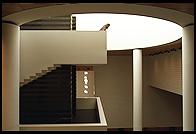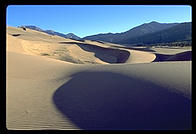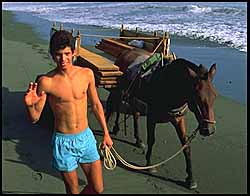
Canon EOS 20-35/2.8
by Philip Greenspun; created 1995
Site Home : Photography : Canon EOS 20-35/2.8
 A big problem with
the 20-35/2.8 is that it is an expensive professional lens without Canon's USM
motor technology. The biggest advantage of the Canon EOS system is that auto and
manual focus are simultaneously available (see my
EOS 5 review). However, that doesn't work with the
older-style motors and it is even theoretically possible to damage them if you
try to work the focus manually when set to Auto (though I do it all the time by
mistake and haven't broken the lens yet).
A big problem with
the 20-35/2.8 is that it is an expensive professional lens without Canon's USM
motor technology. The biggest advantage of the Canon EOS system is that auto and
manual focus are simultaneously available (see my
EOS 5 review). However, that doesn't work with the
older-style motors and it is even theoretically possible to damage them if you
try to work the focus manually when set to Auto (though I do it all the time by
mistake and haven't broken the lens yet).
 It is much
harder to evaluate sharp focus in a Canon viewfinder than in a Nikon. This is a
serious problem with a wide angle lens even when you are viewing at f/2.8.
Everything looks "more or less sharp" and things change rather smoothly as you
turn the focusing ring. Using a Nikon 8008 and 20/2.8 AF lens, I saw a definite
snap into focus. I've never seen that with my Canon, though I have learned to
train myself to be more careful. AF works fine, but if you switch to MF you might
find yourself shooting a bunch of not-very-sharp images. The focus confirmation
lights come on in the finder. You think the camera is focusing but actually it
isn't. The lights came on because you were "sort of close". If AF had been on,
the camera might have moved the ring quite a bit.
It is much
harder to evaluate sharp focus in a Canon viewfinder than in a Nikon. This is a
serious problem with a wide angle lens even when you are viewing at f/2.8.
Everything looks "more or less sharp" and things change rather smoothly as you
turn the focusing ring. Using a Nikon 8008 and 20/2.8 AF lens, I saw a definite
snap into focus. I've never seen that with my Canon, though I have learned to
train myself to be more careful. AF works fine, but if you switch to MF you might
find yourself shooting a bunch of not-very-sharp images. The focus confirmation
lights come on in the finder. You think the camera is focusing but actually it
isn't. The lights came on because you were "sort of close". If AF had been on,
the camera might have moved the ring quite a bit.
Size is manageable, even with the plastic bayonet-mount sunshade. It looks like a professional lens, but isn't really bigger than the 28-105 zooms that a lot of amateurs use. I took the image above in Costa Rica from the back of a horse. I used AF from the exposure lock button.
I miss my Nikon 20/2.8. However, I'm in love with the flexibility of the zoom.
Canon introduced a 17-35/2.8L lens with USM in April, 1996. My friend Rob has one and is testing it now. Presumably it is a better lens to own than the older 20-35.
Text and pictures copyright 1991-1995 Philip Greenspun